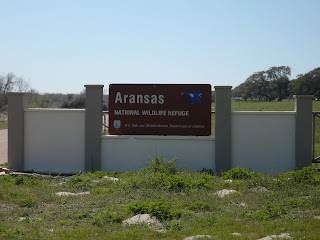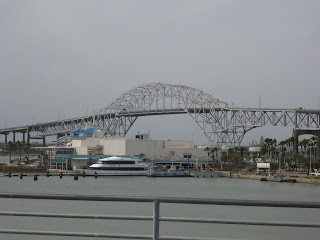Like John Day Fossil Beds, Jean Lafitte National Historic Park & Preserve is another park that’s comprised of various sites scattered all over the place. Each one has a different theme--that should probably be focus—but we are, after all, discussing a park. I’m not entirely sure why the park service decided to name a park after a pirate, but maybe politicians felt a certain connection??
There are 6 Visitor Centers in southern Louisiana. We visited 3 of them: Acadian Cultural Center in Lafayette, Chalmette Battlefield and National Cemetery in Chalmette and Barataria Preserve near Marrero.
 3/29/11 - Acadian Cultural Center: We wandered around the museum looking at exhibits on the Acadian culture until time for the next showing of the movie about how the Acadians from the Canadian Maritimes came to be Cajuns in Mississippi. (Blame the British!) Then we headed to Breaux Bridge. (Note: I’m doing a separate blog for the Cajun Swamp Tour.)
3/29/11 - Acadian Cultural Center: We wandered around the museum looking at exhibits on the Acadian culture until time for the next showing of the movie about how the Acadians from the Canadian Maritimes came to be Cajuns in Mississippi. (Blame the British!) Then we headed to Breaux Bridge. (Note: I’m doing a separate blog for the Cajun Swamp Tour.) 3/31/11 – Chalmette: Chalmette Battlefield was the site of the Battle of New Orleans in 1815, and the Chalmette National Cemetery has over 15,000 graves of veterans from the Civil to Vietnam wars. We used the GPS and ended up at the cemetery but couldn’t figure out where to park. A ranger explained to us where the Visitor Center was, let us drive through on a maintenance road. We came in from the wrong end of the road, but headed to the Visitor Center. We checked out the exhibits, then watched the video about the battle. We learned a whole lot more about the importance of the battle there than we did in High School! There’s a self-guided tour that goes all around the battlefield, so we hopped in the truck and went back to see the American ramparts and cannon. The US cannons are/were painted in US regulation colors: sky blue and black. I guess if the British are wearing red coats, then painting the canons light blue fits right in. Only one canon was black (actually Spanish red and black)—a 32 pounder that had been commandeered from a Navy ship.
3/31/11 – Chalmette: Chalmette Battlefield was the site of the Battle of New Orleans in 1815, and the Chalmette National Cemetery has over 15,000 graves of veterans from the Civil to Vietnam wars. We used the GPS and ended up at the cemetery but couldn’t figure out where to park. A ranger explained to us where the Visitor Center was, let us drive through on a maintenance road. We came in from the wrong end of the road, but headed to the Visitor Center. We checked out the exhibits, then watched the video about the battle. We learned a whole lot more about the importance of the battle there than we did in High School! There’s a self-guided tour that goes all around the battlefield, so we hopped in the truck and went back to see the American ramparts and cannon. The US cannons are/were painted in US regulation colors: sky blue and black. I guess if the British are wearing red coats, then painting the canons light blue fits right in. Only one canon was black (actually Spanish red and black)—a 32 pounder that had been commandeered from a Navy ship. We saw the battlefield from both the American and the British side. Not as large as you’d think—and yet it is. On one side is the Mississippi. The field is really swampy and the day we were there it had standing water in several places. Must have been a terrible place to have to cross. I’ve still got chunks of the song in my head…let me know if you can remember more than the first verse, the chorus—and of course, the part about the gator!
The cemetery location was part of the battlefield. It was established as a burial place for Union soldiers who died in the Gulf area during the Civil War. Only 4 soldiers from the Battle of New Orleans are buried there. It’s a quiet peaceful place.

3/31/11 – Barataria Preserve. George really got into Chalmette, and I had to remind him that we still had another place to go. From the park, we drove to the Chalmette Ferry—right next to a big refinery—to cross the Mississippi. Obviously we Washingtonians know ferries—this was definitely not the Puyallup! I told my son that we rode backwards across the Mississippi and he wrote back “Don't you know that you cross the Mason-Dixie timeline when you cross the Mississippi backwards and screw up the space-time continuum and could reverse the entire Civil War and those Damn Yankees could actually LOSE if you keep that up?" So let me explain about the Chalmette ferry: unlike Washington ferries, where you drive on one end and drive off the other end when it docks, this little ferry only goes one direction. You drive on and loop around like a u-turn, and get off on the same end you drove in on. There were enough other cars in front of us that we didn't get to the loop end and that's why we rode backwards!
 When we got to the Visitor Center at Barataria, the ranger explained that we had to be out of the park by 5:00 pm or we’d be locked in! Since George didn’t want to park outside the gates alongside the road, we had to scurry to get down to the Alligator Marsh and back again. The trail goes through the forest, then on boardwalks through the swamps and marshes. We did see a couple of alligators, and some turtles and lizards. We saw just a few Giant Blue Iris in bloom—but there are areas where there are huge fields of them. Sure would be nice if we could time our trips with the local wildflower bloom time better.
When we got to the Visitor Center at Barataria, the ranger explained that we had to be out of the park by 5:00 pm or we’d be locked in! Since George didn’t want to park outside the gates alongside the road, we had to scurry to get down to the Alligator Marsh and back again. The trail goes through the forest, then on boardwalks through the swamps and marshes. We did see a couple of alligators, and some turtles and lizards. We saw just a few Giant Blue Iris in bloom—but there are areas where there are huge fields of them. Sure would be nice if we could time our trips with the local wildflower bloom time better.  We went back to the RV park (located on the “northshore of New Orleans”—that means the north side of Lake Pontchartrain), going over the Huey Long bridge, through parts of New Orleans, then crossing the 23-mile causeway across the lake. It’s the longest bridge in the US, and I thought it would be more interesting…but it’s kind of boring, not much to see but water and the cars in front of you. There are 2 drawbridges and lots of call boxes. Eventually (yawn) we made it across, then struggled with rush-hour traffic through Covington.
We went back to the RV park (located on the “northshore of New Orleans”—that means the north side of Lake Pontchartrain), going over the Huey Long bridge, through parts of New Orleans, then crossing the 23-mile causeway across the lake. It’s the longest bridge in the US, and I thought it would be more interesting…but it’s kind of boring, not much to see but water and the cars in front of you. There are 2 drawbridges and lots of call boxes. Eventually (yawn) we made it across, then struggled with rush-hour traffic through Covington.There are three other sites for Jean Lafitte that we didn’t visit—but we will next time! French Quarter Visitor Center in New Orleans, Prairie Acadian Cultural Center in Eunice and Wetlands Acadian Cultural Center in Thibodaux.
























